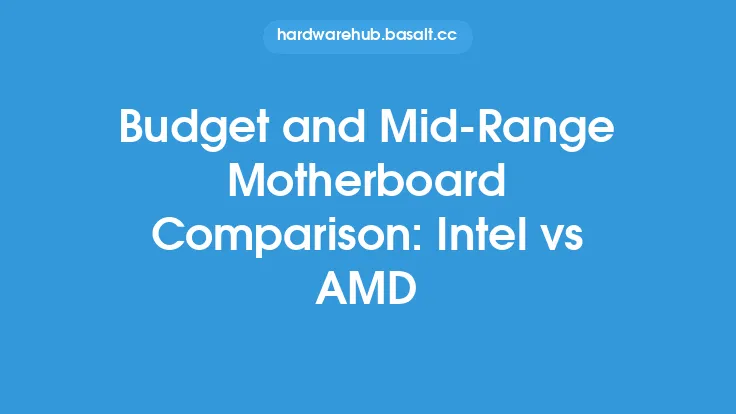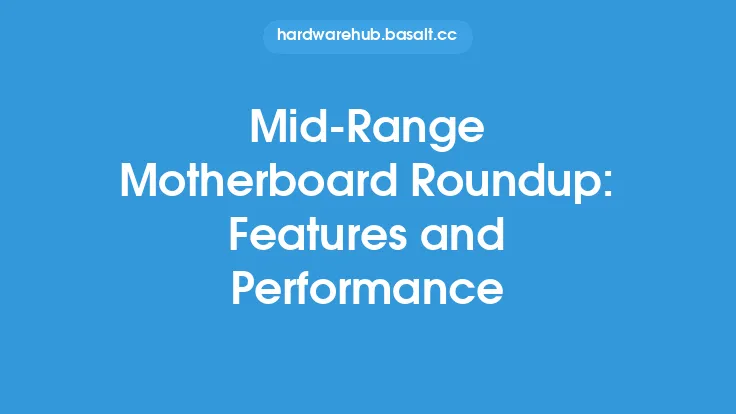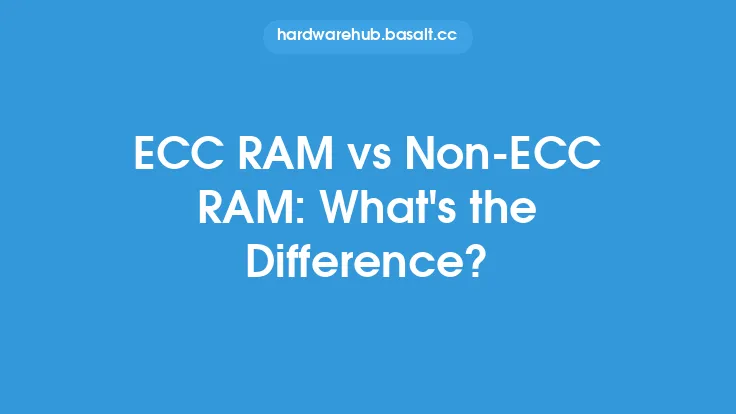When it comes to building or upgrading a computer, one of the most critical components to consider is the motherboard. The motherboard serves as the main circuit board that connects all the hardware components together, allowing them to communicate and function properly. For those on a budget, the decision often comes down to choosing between a budget motherboard and a mid-range motherboard. While both options can provide a functional system, there are significant differences between them that can impact performance, features, and overall value.
Overview of Budget Motherboards
Budget motherboards are designed to provide the basic features and functionality needed to run a computer at an affordable price. These motherboards typically use lower-cost components, such as capacitors, voltage regulators, and PCB materials, to keep costs down. They often have fewer features, such as limited USB ports, SATA ports, and PCIe slots, and may not support advanced technologies like Wi-Fi, high-speed USB, or high-quality audio. Budget motherboards are usually based on older chipsets or less powerful processors, which can limit their performance and upgradability. Despite these limitations, budget motherboards can still provide a reliable and functional system for basic tasks like web browsing, office work, and streaming media.
Overview of Mid-Range Motherboards
Mid-range motherboards, on the other hand, offer a balance between features, performance, and price. These motherboards use higher-quality components, such as solid capacitors, improved voltage regulators, and better PCB materials, which can improve their reliability and durability. Mid-range motherboards often have more features, such as additional USB ports, SATA ports, and PCIe slots, as well as support for advanced technologies like Wi-Fi, high-speed USB, and high-quality audio. They may also have better power delivery systems, which can improve their ability to handle demanding workloads and overclocking. Mid-range motherboards are usually based on more recent chipsets and processors, which can provide better performance, upgradability, and compatibility with newer hardware and software.
Key Differences
One of the main differences between budget and mid-range motherboards is the quality of their components. Mid-range motherboards tend to use higher-quality components, which can improve their reliability and durability. For example, mid-range motherboards may use solid capacitors, which are less prone to leakage and failure, while budget motherboards may use lower-cost electrolytic capacitors. Another key difference is the number and type of features available. Mid-range motherboards often have more USB ports, SATA ports, and PCIe slots, which can provide more flexibility and expansion options. They may also have better power delivery systems, which can improve their ability to handle demanding workloads and overclocking.
Performance Comparison
In terms of performance, mid-range motherboards tend to outperform budget motherboards due to their better components and more advanced features. Mid-range motherboards may have faster USB ports, such as USB 3.2 Gen 2, which can provide faster data transfer speeds. They may also have better storage options, such as M.2 NVMe SSD support, which can provide faster storage performance. Additionally, mid-range motherboards may have more advanced power delivery systems, which can improve their ability to handle demanding workloads and overclocking. However, the performance difference between budget and mid-range motherboards may not be dramatic for basic tasks like web browsing and office work.
Feature Set Comparison
Another key difference between budget and mid-range motherboards is their feature set. Mid-range motherboards often have more advanced features, such as Wi-Fi, high-quality audio, and high-speed USB. They may also have more expansion options, such as additional PCIe slots and SATA ports. Budget motherboards, on the other hand, may have more limited features and expansion options. However, some budget motherboards may still offer advanced features like Wi-Fi and high-quality audio, although they may not be as robust or reliable as those found on mid-range motherboards.
Power Delivery and Overclocking
Mid-range motherboards tend to have better power delivery systems, which can improve their ability to handle demanding workloads and overclocking. They may have more phases, better voltage regulators, and more advanced cooling systems, which can provide more stable and efficient power delivery. Budget motherboards, on the other hand, may have more limited power delivery systems, which can limit their ability to handle demanding workloads and overclocking. However, some budget motherboards may still offer basic overclocking features, such as CPU multiplier adjustment and voltage adjustment.
Conclusion
In conclusion, the main difference between budget and mid-range motherboards is the balance between features, performance, and price. Budget motherboards provide basic features and functionality at an affordable price, while mid-range motherboards offer a balance between features, performance, and price. While budget motherboards can still provide a reliable and functional system for basic tasks, mid-range motherboards offer more advanced features, better performance, and more expansion options. Ultimately, the choice between a budget and mid-range motherboard depends on your specific needs and budget. If you're looking for a basic system for web browsing and office work, a budget motherboard may be sufficient. However, if you're looking for a more advanced system with better performance, features, and upgradability, a mid-range motherboard may be a better option.





